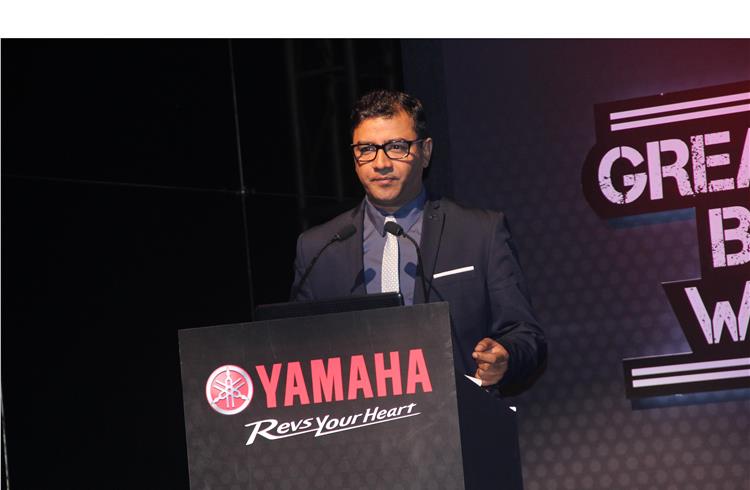'Expect a lot of action in the entry level 250cc bike market.'
Roy Kurian, senior VP, sales and marketing, Yamaha Motor India Sales, on aiming for sales of 3,000 FZ25s and 5,000 Fazer 25s each month, his bullishness on the midsize bike market, revising the 2017 target to 900,000 units.
Roy Kurian, senior vice-president, sales and marketing, Yamaha Motor India Sales, speaks to Amit Panday on the sales target for the recently launched FZ 25, the growth of the midsize motorcycle segment and why the company has revised its sales target for 2017 to 900,000 units from the earlier million units.
At the entry level in the surging midsize motorcycle category, Yamaha has the FZ 25 and Fazer 25 while the lightweight street bike MT-09 sits at the top end. What is your assessment and outlook of the midsize bike market?
The midsize segment customer is upgrading from the typical 125cc-150cc motorcycles. More customers will step into the midsize motorcycle segment in the next three years, thanks to the new emission and safety norms and increasing disposable incomes among the buyers. Hence, they would like to have motorcycles with bigger powertrains.
I believe that a lot of traction will happen around the entry level 250cc segment. Besides the buyers who are upgrading from smaller models, the majority of first-time motorcycle customers would be coming to the entry level midsize segment because aspiration levels are growing rapidly. These aspirations are triggered by the imported CBUs (Completely Built Units) now often seen on the roads.
Although not everyone can afford a big muscular superbike, a stylish value-for-money, smaller in size, performance-oriented motorcycle will be bought by such customers. I do see a lot of fresh motorcycle customers opting for the Yamaha FZ 25 and Fazer 25 models.
We have to thoroughly study the price points that will suit the technology desired by the customer. For example, we sell the 150cc R15 for Rs 120,000. At the same time, we are offering a 250cc for Rs 119,000. So we are looking at the relative price points wherein customer needs are met. This can range from racing applications to touring comfort and fuel efficiency features. I think the premium segment will grow the most.
How is the strategy at the top end of this booming segment working for Yamaha? How has the big bike market responded to the MT-09’s arrival in India? The MT-09, along with the MT-07, is a big hit in Europe.
The 2017 edition of the MT-09 model has been introduced globally, although not yet in India. I believe that the potential customers of the MT-09 in India have not understood the motorcycle. A typical CBU is expected to look big and heavy. However, the MT-09’s real character is in stark contrast of that.
The MT-09 is one motorcycle that can be understood only after riding it for a few kilometres. European customers, on the other hand, perceive big bikes differently than Indian customers. Yes, the MT-09 is a big hit in Europe. The MT-09 and MT-07 both have done very well in the European markets. These two models turned around the market for Yamaha.
Do you think there is a market for the MT-07 in India?
We will have to study the prospects first. I cannot comment on this any further.
You said Yamaha is working to commence group rides promoting the Fazer 25 (and FZ 25) soon. What is the company doing to promote the MT-09 in India?
I agree we have to work on it and we will do so. We will have to offer the bike(s) to the potential customers for rides. We have also to promote the model digitally, I believe.
Yamaha was gunning for sales of one million units in CY2017. Why has the company now revised its annual target to 900,000 units now?
We have revised the sales target because of the external factors that have impacted us. Firstly, the impact of demonetisation continued until April and it can be seen in our monthly performances. Secondly, the transition from BS III norms to BS IV standards led to a cut down in production at our plants. We had cut down the production of BS III-compliant models in January earlier this year and we manufactured only the BS IV models February 2017 onwards. That impacted our monthly billings largely for those months. This is the reason why our inventory levels were very low around March 30 and 31 when big discounts on two-wheelers were offered across the country.
Yamaha is currently growing at a rate lower than that of the two-wheeler industry so far this year. Will you recover?
Yes, we will recover for sure. I do not see any such intervention for the remaining part of the year so I am hoping that our sales will pick up in the market.
We will grow better than the industry by the end of this year. We are very positive on the incoming festive season this year. It should be the best ever festive seasons for us and we are strongly banking on our portfolio of scooters and motorcycles for the same. This year, we anticipate that 55 percent of our overall sales come from scooters and the remaining from the motorcycles.
RELATED ARTICLES
BRANDED CONTENT: 'We aspire to be among the leading sensors and electro-mechanical products manufacturer'
P. Parthasarathy, Founder & Managing Director, Rotary Electronics Pvt Ltd shares the company's commitment and vision to ...
‘Big opportunity for startups lies in products in India’: Detlev Reicheneder
As electrification levels the playing field, the focus on tech and R&D to bring innovative products is the mantra for st...
'I hope my journey makes people say — I can do this too'
Ranjita Ravi, Co-founder of Orxa Energies — the maker of Mantis e-bikes — shares the challenges of building a startup an...





 By Autocar Pro News Desk
By Autocar Pro News Desk
 16 Sep 2017
16 Sep 2017
 9902 Views
9902 Views









